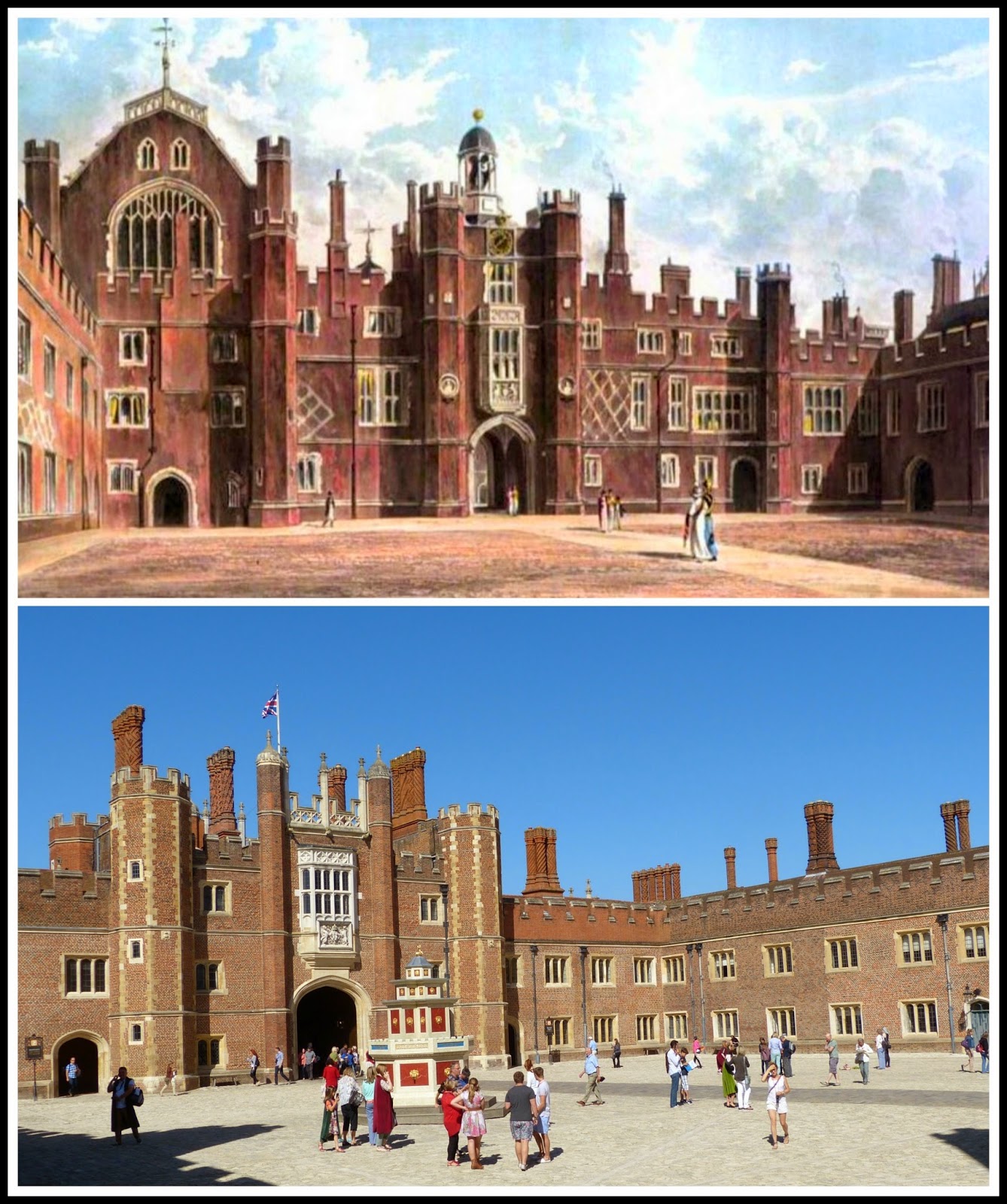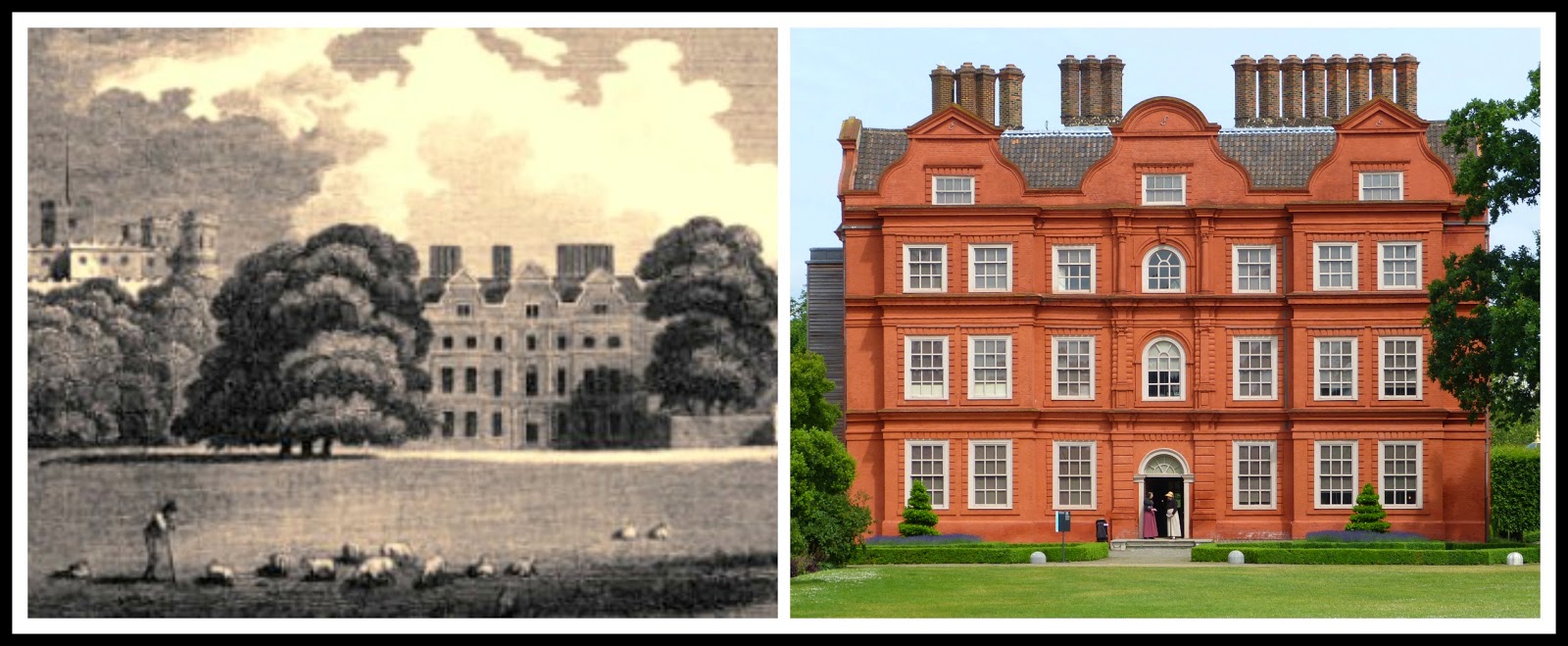George IV made the Royal Pavilion at Brighton his summer residence from 1786 until 1827, when he abandoned it as lacking in privacy. It started life as a modest farmhouse and was redeveloped into the magnificent, if somewhat eccentric, palace that exists today.
 |
| Top: Brighton Pavilion from History of Brighton and its environs by R Sickelmore (1827) Bottom: Brighton Pavilion (2004) © Andrew Knowles |
George IV’s Brighton
George IV and the Marine Pavilion, Brighton
George IV and the Brighton Pavilion
What did Regency visitors think of the Brighton Pavilion?
Watch my video: A litter of cupolas – Brighton Pavilion in 1823
Buckingham Palace
Buckingham Palace was acquired by George III as a private residence for the royal family in 1761 and was originally known as Buckingham House or the Queen’s House. George IV transformed it into a palace fit for a king, but did not live to see it completed. William IV disliked it and would not live there, but it became the official London residence of Queen Victoria and British monarchs ever since.
 |
| Top: Buckingham House from The History of the Royal Residences by WH Pyne (1819) Bottom: Buckingham Palace (2015) © Andrew Knowles |
William IV resided at Bushy House from 1797 when, as Duke of Clarence, he was appointed Ranger of Bushy Park. He lived there with his mistress, Dorothea Jordan, until their relationship ended in 1811, and then later with his wife Princess Adelaide. He continued to live at Bushy House even after he became king and following his death, it became the official residence of Queen Adelaide until her death in 1849. In 1900, the site was offered to the Royal Society to house the National Physical Laboratory and ceased to be a royal residence.
 |
| Top: Bushy House from History of the life and reign of William the Fourth (1837) by R Huish Bottom: The house in Bushy Park (2014) © Andrew Knowles |
Carlton House was purchased as the official residence of Frederick, Prince of Wales, George III’s father, in 1732. In 1783, it became the residence of the future George IV when he came of age. George IV continually remodelled it until he became king, at which point he transferred his interest to the other royal residences. It was demolished in 1825 and replaced by a number of prestigious houses - Carlton House Terrace.
 |
| Left: Carlton House, south front, from The History of the Royal Residences by WH Pyne (1819) Right: Carlton House Terrace (2015) © Andrew Knowles |
Clarence House was built in 1825-7 as the London residence of William IV when he was Duke of Clarence. He continued to live there after he became king in 1830. Following his death, it became the residence of Princess Augusta and the Princess Victoria, Duchess of Kent, Queen Victoria’s mother. It is now the official residence of the Prince of Wales.
 |
| Top: Clarence House from The Graphic (Nov 1874) Bottom: Clarence House (2015) © Andrew Knowles |
George III visited Weymouth nearly every year from 1789 to 1805 and stayed at Gloucester Lodge, the house built for his brother William, Duke of Gloucester, on the seafront. It was sold by George IV when he became king and is now a hotel.
 |
| Top: Weymouth seafront from The Lady's Magazine (1789) Bottom: Gloucester Lodge (2012) © Andrew Knowles |
George III in Weymouth
Sea bathing in Regency Weymouth
Fashionable entertainment in Regency Weymouth
Watch my video: George’s seaside adventure - George III in Weymouth
Hampton Court
Hampton Court first became a royal residence after it was acquired by Henry VIII in 1528 and rebuilt to his design. It was used by the early Georgian monarchs, but under George III, the palace was divided up into grace-and-favour apartments – rent-free accommodation for those favoured by the King. It is now in the care of Historic Royal Palaces and is open to the public.
 |
| Top: Quadrangle, Hampton Court, from The History of the Royal Residences by WH Pyne (1819) Bottom: Hampton Court (2014) © Andrew Knowles |
William III and Mary bought Nottingham House in 1689 and transformed it into Kensington Palace, an out-of-town royal residence in which to live in preference to St James’s Palace. It was renovated under George I and used extensively by George II. Members of the royal family continued to live there, but it was never used as the residence of the sovereign again. Kensington Palace is in the care of Historic Royal Palaces and is open to the public.
 |
| Top: Kensington Palace from The History of the Royal Residences by WH Pyne (1819) Bottom: Kensington Palace (2012) © Andrew Knowles |
Kew Palace
George II first used Kew Palace as a royal residence for part of his family from 1729. George III housed his two eldest sons here whilst using the White House, Kew, as a country retreat. Kew Palace was used during George III’s mentally incapacitating illness and Queen Charlotte died there in 1818. Queen Victoria gave the palace to the public and it is now managed by Historic Royal Palaces.
 |
| Left: The old palace at Kew from Memoirs of HM Sophia Charlotte of Mecklenburg Strelitz, Queen of Great Britain by WM Craig (1818) Right: Kew Palace (2014) © Andrew Knowles |
Kew Palace
Kew Gardens
Queen Charlotte’s Cottage, within Kew Gardens
St James’s Palace
Built for Henry VIII in the 1530s, St James’s Palace became the principal London palace of the British sovereign after the Palace of Whitehall was destroyed by fire in 1698. Part of the St James’s Palace was destroyed by fire in 1809, but court levées were still held here until 1939. It remains an official residence although no sovereign has resided here since the time of William IV.
 |
| Top: St James's Palace from The History of the Royal Residences by WH Pyne (1819) Bottom: St James's Palace (2014) © Andrew Knowles |
Frederick, Prince of Wales, George III’s father, lived in the White House at Kew from 1730. George III inherited the White House from his mother and used it as a country retreat. George III was incarcerated here during several bouts of mental illness and he ordered its demolition in 1802. All that remains to mark the site is a sundial opposite to Kew Palace.
Windsor Castle
Windsor Castle has been a royal residence since about 1100. It was a favoured out-of-town residence of both George III and George IV who carried out extensive building works at the castle. It remains an official residence of the King today.
 |
| Top: The Upper Ward, Windsor Castle from The History of the Royal Residences by WH Pyne (1819) Bottom: The Lower Ward, Windsor Castle (2015) © Andrew Knowles |
Windsor Castle
St George’s Chapel, Windsor Castle
1815 exhibition: Waterloo at Windsor 1815-2015
Updated 30/9/22
Rachel Knowles writes faith-based Regency romance and historical non-fiction. She has been sharing her research on this blog since 2011. Rachel lives in the beautiful Georgian seaside town of Weymouth, Dorset, on the south coast of England, with her husband, Andrew.
Find out more about Rachel's books and sign up for her newsletter here.If you have enjoyed this blog and want to encourage me and help me to keep making my research freely available, please buy me a virtual cup of coffee by clicking the button below.
Sources used include:
Craig, William Marshall, Memoirs of HM Sophia Charlotte of Mecklenburg Strelitz, Queen of Great Britain (1818)
Huish, Robert, History of the life and reign of William the Fourth (1837)
Pyne, WH, The history of the Royal Residences of Windsor Castle, St James's Palace, Carlton House, Kensington Palace, Hampton Court, Buckingham House and Frogmore (1819)
Rocque, John, A New Plan of Richmond Garden (1748)
Sickelmore, Richard, History of Brighton and its environs (1827)
The Graphic (1874)
The Lady's Magazine (1789)
Historic Royal Palaces website
Royal Collection Trust website
The official website of The British Monarchy
Craig, William Marshall, Memoirs of HM Sophia Charlotte of Mecklenburg Strelitz, Queen of Great Britain (1818)
Huish, Robert, History of the life and reign of William the Fourth (1837)
Pyne, WH, The history of the Royal Residences of Windsor Castle, St James's Palace, Carlton House, Kensington Palace, Hampton Court, Buckingham House and Frogmore (1819)
Rocque, John, A New Plan of Richmond Garden (1748)
Sickelmore, Richard, History of Brighton and its environs (1827)
The Graphic (1874)
The Lady's Magazine (1789)
Historic Royal Palaces website
Royal Collection Trust website
The official website of The British Monarchy
© RegencyHistory




No comments:
New comments are not allowed.